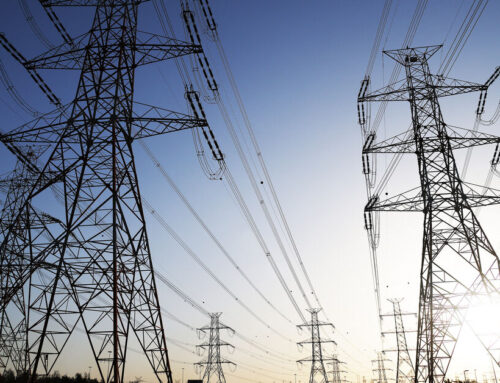Data Center Developer Secures Long-Term Lease of Cayuga Power Plant
October 5, 2025
The owners of the Cayuga Power Plant in Lansing have entered a long-term deal to lease the former coal-fired power plant to a company that develops data centers.
TeraWulf Inc. announced an 80-year lease of a 183-acre portion of the site in an Aug. 14 press release.
“This transaction marks a major step forward in the company’s expansion of high-performance computing (HPC) and AI data center hosting,” the press release stated. The deal was announced as TeraWulf secured a multi-billion dollar investment from Google.
The plan to convert the power plant into a data center has been in the works for years.
What is a Data Center?
A data center is a facility that houses large-scale computing machines that work together to process, store and share data. These facilities are the backbone of artificial intelligence platforms such as ChatGPT and are used to mine cryptocurrencies such asBitcoin. A single data center uses an immense amount of energy, with estimates comparable to the energy required to power an entire city.
According to the Department of Energy, the amount of energy used by data centers is expected to triple by 2028.
“Data centers consumed about 4.4% of total U.S. electricity in 2023 and are expected to consume approximately 6.7 to 12% of total U.S. electricity by 2028,” the DOE report stated.
Another report from the International Energy Agency (IEA) says that global electricity demand from data centers will more than double by 2030 to around 945 terawatt-hours (TWh), which is slightly more than the entire electricity consumption of Japan. It added that in the United States, “[The] economy is set to consume more electricity in 2030 for processing data than for manufacturing all energy-intensive goods combined.”
New York state Assemblymember Anna Kelles said the increased energy demand comes at a time when the state is failing to create energy efficiency in its current base load, and she’s concerned that it will significantly increase residents’ electric bills.
“There’s no precedent for this,” Kelles said. “There has never been a technology that has increased energy demand this fast.”
Kelles told the Ithaca Times that the data center proposed at the Cayuga Power Plant will use a maximum of 400 megawatts, equivalent to the energy consumption of about 350,000 homes. To put that in perspective, the entire population of the City of Ithaca is around 33,000 and the entire population of Tompkins County is around 105,000. The data center at the Cayuga Power Plant could consume over four times as much energy as all of Tompkins County, which Kelles said uses an average total of 87 megawatts annually.
Tompkins County Legislator and Lansing resident Mike Sigler, however, has said that while 400 megawatts is the facility’s maximum capacity, he believes that the current project will use only 50 megawatts due to the limits of the current infrastructure connecting the facility to the grid. Sigler said he understood concerns about data centers contributing to water and noise pollution, but that TeraWulf representatives assured him no water from Cayuga Lake would be used to cool the facility and that measures will be taken to keep noise below local limits.
Over the last several years, at least two data centers have started operating within a 50-mile radius of Tompkins County. These are the 107 megawatt Greenidge Generation facility in Dresden and the FirstLight facility within the renovated Seneca Army Depot in Romulus.
As the number of data centers has increased locally, so have energy prices. In 2023 New York State Electric & Gas (NYSEG), the regional utility monopoly for Ithaca and Tompkins County, implemented a 62% staggered rate increase over three years. The final phase of that increase went into effect this past May, but NYSEG requested another increase of 34.7% less than a month later. This occurs as more people struggle to afford rising utility bills, and the corporations that own these utility companies earn billions of dollars in profit.
While energy costs have increased as data centers have become more widespread, TeraWulf said that electricity costs depend on many factors beyond just data centers. In response to a question about if this facility will increase energy prices, TeraWulf’s FAQ page of its website states that it doesn’t anticipate the project putting “upward pressure on prices” due to a surplus of clean energy generation in Zone C of the New York Grid.
Economic and Environmental Impacts of Data Centers
According to a study from Carnegie Mellon University, the rapid spread of data centers across the country could increase the average cost of electricity by 8%, with greenhouse gas (GHG) emissions increasing by 30% due to the operations of these facilities. While the study estimates an average increase of 8% for electricity costs, it said that some regions could be hit with increases as high as 25%.
The spread of data centers has been connected to increases in energy prices because these facilities add demand to the energy grid without providing much, or any, energy in return. According to the law of supply and demand, when demand increases and supply cannot catch up fast enough, prices rise.
Kelles said this issue is made even worse by the prevalence of power purchase agreements between the companies that own data centers and the utility companies that provide energy. Kelles said these agreements provide data centers below-market rates for their energy usage in return for being a large energy user. She added that instead of the utility companies taking on the burden of this cost differential, energy providers shift the costs onto the rest of the ratepayers in the area.
“We have these private companies coming in and taking all of our energy, redirecting it to their facilities, paying sub-market rates, taking massive profits out of the community, and leaving the community hamstrung with higher electric bills when everyone is already struggling,” Kelles said. “This is insane […] if they’re going to use energy from the grid, they need to pay the same fair market rate everyone else does.”
These facilities also increase GHG emissions because many of them, such as the Greenidge facility, operate by burning fracked natural gas. While the Greenidge facility is powered entirely by fossil fuels, the TeraWulf’s data center will be partially powered by renewable energy.
Terawulf has attempted to address concerns about greenhouse gas emissions by saying that the data center will be partially powered by a 67-megawatt solar farm adjacent to the facility. The company has said that it plans on powering the facility with 138 megawatts of renewable energy, leaving 262 megawatts to be powered by unspecified means, which will likely include fossil fuels.
While the data center will be partially powered by renewable energy, Kelles said that the solar farm that will be used to power the facility was supposed to generate power for the community, but that it will now be diverted to the data center.
“We’re getting a solar field, but none of the energy will benefit our system because it will all be directed to this facility,” Kelles said. She said this means more renewable energy infrastructure will need to be built in order to meet the state’s clean energy goals.
Kelles is concerned the state will rely more on nuclear power to meet both the clean energy goals it’s behind on and the energy demand of data centers.
“I’m hearing concerns from residents that they are going to, out of the blue, put forward a proposal to put a small nuclear plant on the property,” Kelles said. “People should be very concerned.”
According to Kelles, “the state’s draft energy plan explicitly highlights nuclear energy […] as part of engineering a diverse, clean and reliable energy portfolio.” She added that the New York State Energy Research and Development Authority (NYSERDA) is gathering stakeholder input to assess the feasibility of advanced nuclear technologies.
Residents Speak Out
TeraWulf’s data center was the main topic of a contentious conversation at a recent Lansing Town Board public hearing held on Sept. 22. During the hearing, residents and representatives from TeraWulf discussed whether the Town Board should pass a year-long moratorium on large-scale development in Lansing, which would temporarily halt TeraWulf’s plans to move forward with building the data center. The board moved the final vote on the moratorium to their October meeting.
Representatives from TeraWulf urged the board to oppose the moratorium, saying it unfairly targets the data center. They added that the project would have a positive impact on the local economy by creating 500 temporary construction jobs, 100 permanent jobs, and investing $400 million into the redevelopment of the site that has sat vacant since 2019. The board, however, said the moratorium isn’t intended to target the data center but rather pause large-scale development as the town updates its zoning laws to align with its comprehensive plan, which was last updated in 2018.
Town of Lansing Supervisor Ruth Groff said that the town has faced delays in updating their zoning laws since approving the new comprehensive plan, but the $100,000 Smart Growth Community Grant it received in 2024 helped start the process. Groff said that the board awarded the consulting contract for the zoning rewrite project to Colliers Engineering & Design during its Sept. 17 meeting. She added, “now that the process is officially underway, the board is discussing whether to move forward with this moratorium.”
While some residents opposed the moratorium, believing the data center would benefit the community, a number of locals supported the moratorium due to concerns of how data centers will affect the environment and local energy prices. Others opposed the moratorium for temporarily halting both commercial and industrial development, saying it should be amended to exclude commercial development so small businesses wouldn’t be negatively impacted.
The board will now consider whether or not to vote on the moratorium as is, or if it will make changes to the law in response to public comments. If any changes are made, the board will have to hold another public hearing for residents to provide comments before a final vote is made.
Legal and Political Responses
New York State Governor Kathy Hochul signed a law establishing a two-year moratorium on proof-of-work cryptocurrency mining in 2022, which expired at the end of 2024. The Department of Environmental Conservation (DEC) just finished accepting public comment on its Draft Generic Environmental Impact Statement (DGEIS), which will lay out how the state will regulate cryptocurrency mining data centers.
The DGEIS states that it “aims to consider potential environmental impacts of [proof-of-work cryptocurrency mining], as well as the social costs and benefits to host communities.” According to the DGEIS, there are currently 11 cryptocurrency mining facilities throughout the state, but it’s difficult to know how many of these facilities are using proof-of-work or proof-of-stake mining, which is less energy intensive.
“The publicly available data do not include the validation method so therefore it cannot be reliably ascertained whether a CMO is utilizing PoW to validate blockchain transactions,” stated the DGEIS. “CMOs are not currently obligated to report their electrical demand and therefore detailed usage information for PoW CMOs is not publicly available.”
The DGEIS stated that the 11 facilities derive a majority of their power from the state’s energy grid as opposed to having an on-site power source, meaning that these facilities are diverting energy away from powering local communities and towards corporations seeking to capitalize on the artificial intelligence market. The facilities have a total electric demand of approximately 7.7 TWh, and grid-connected operations account for 6.1 TWh while facilities that use on-site energy generation account for just 1.6 TWh. The DGEIS added, “Total estimated GHG emissions from the known facilities is estimated at 3 million metric tons (MMT) carbon dioxide equivalent (CO2e) per year.”
Kelles said she is working on a bill requiring data centers to regularly report their energy usage, including the types of energy used, greenhouse gas emissions, waste heat, water usage, water pollution, and labor practices. It would also prevent data centers and utility companies from making power purchase agreements.
Yvonne Taylor, vice president of nonprofit Seneca Lake Guardian and co-founder of the National Coalition Against Cryptomining, has urged the DEC to finalize its environmental impact statement so the state can move forward with legislation prohibiting data centers from using proof-of-work cryptocurrency mining.
“DEC’s DGEIS rightly makes it clear that energy-intensive cryptomining is not a responsible use of energy, whether from fossil fuels or our limited renewable resources supply,” Taylor said. “The most sustainable option laid out is to prohibit Proof of Work cryptomining altogether.”
Taylor said the spread of data centers will create an unsustainable energy demand, making it nearly impossible to meet New York’s climate goals under the Climate Leadership and Community Protection Act.
“Continued growth of these operations would require even more renewable capacity, undermining the very transition we’re working toward with the CLCPA,” she said.
The state has quietly backtracked on the clean energy goals set by the CLCPA, claiming that the current political climate is making it more difficult to meet them. Kelles said this doesn’t hold up to scrutiny and that the state has deliberately undermined its own goals by not following through on several aspects of its climate law.
“The state drafted a roadmap for us to achieve the CLCPA. It’s disingenuous to say we’re falling behind because of the current political climate and therefore we are just going to throw it away,” Kelles said. She said that the roadmap included implementing Cap-and-Invest, a program which would set a limit on greenhouse gas emissions while investing in renewable energy infrastructure, but the policy has yet to be implemented.
Kelles added that the New York Build Public Renewables Act passed in 2023 says, “if at any point we find that we are off track to reach our CLCPA goals, the New York Power Authority can step in and add renewable energy infrastructure to get us back on track to meet our goals.” However, Kelles said that this isn’t being done either.
“They’ve put out a proposal, but it hasn’t been funded,” Kelles said. “It is super disingenuous to say that we have to bring back in nuclear and natural gas infrastructure, because we’re not reaching our CLCPA goals, if you’re simultaneously hindering implementing the very steps that would get us to reaching our goals.”
Kelles said that if Governor Kathy Hochul released the draft cap and invest regulations when they were supposed to be released and enacted the policy two years ago, the state would have already raised around $5 billion that could have been directly invested into renewable energy infrastructure.
She added that part of the reason why Hochul has refused to implement the policy is due to lobbying from the fossil fuel industry. “There’s tremendous pushback from the industry, because they don’t want to pay for it,” Kelles said.
Search
RECENT PRESS RELEASES
Related Post




